|
Riding an ATV is a fun way to explore the outdoors, and getting all geared up with appropriate riding clothes and equipment is all part of the excitement.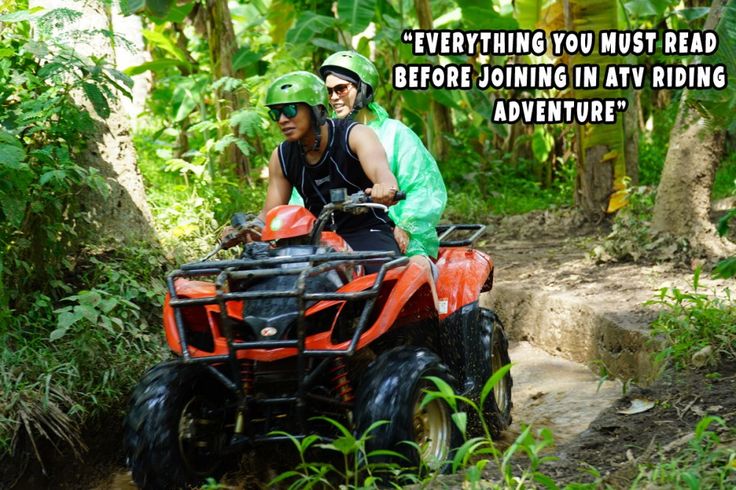 But before you set off into the beckoning trails, it’s essential to learn how to drive an ATV safely and correctly.
But before you set off into the beckoning trails, it’s essential to learn how to drive an ATV safely and correctly.
To drive an ATV, start with pulling in the clutch. Next, shift from neutral gear to first gear, then press the throttle slowly while gradually releasing the clutch. Once the ATV starts moving, you can shift through the gears to speed up. Brake the front wheels by squeezing the right hand lever. Brake the rear wheels with the right foot pedal.
If you’re new to ATVs and would like to learn how to drive one, here’s a quick start guide to get you started.
To get started, ensure you have a suitable ATV that beginners like yourself can drive. Try sitting on the ATV to feel how comfortable it is, and make sure that you can easily reach the handles and gears. Also, you want to avoid using an ATV that’s too powerful, big, or unwieldy, as this could end up causing an accident while you’re still learning.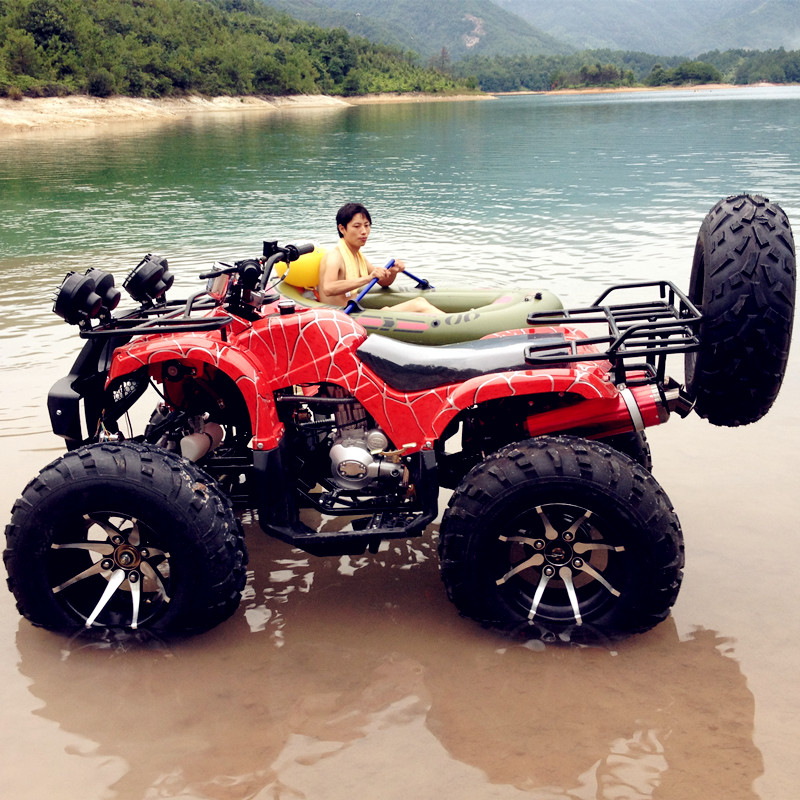
For more info on buying an ATV check out my How To Shop For an ATV Guide.
When you start riding, select a wide, flat, and open space without hazards or obstacles in the way (fallen trees, sticks, ditches). Until you’re comfortable using the ATV’s controls, you may want to avoid steep terrain, vehicles, or objects that would require you to navigate around them.

For a beginner, it might be easier to learn how to drive using an automatic ATV. However, with practice, a manual clutch isn’t a bad choice either. The biggest hurdle is getting the coordination between your hands and feet right.
Here’s a helpful overview video before we get started, with more info below:
Now, here’s a step by step guide on how to drive an ATV:
To start the ATV, insert the key into the ignition, then turn it to the start position. Next, press the start button located towards the right of your handlebars. Once the engine starts, let it run for a minute or so to heat up. You can leave the engine running for up to 5 minutes before riding when the weather is cool.
Once the engine starts, let it run for a minute or so to heat up. You can leave the engine running for up to 5 minutes before riding when the weather is cool.
To set the engine into neutral, pull the clutch lever located on the left handlebar. This action places the engine into neutral gear, allowing you to shift gears as you increase your speed. Use your left hand to engage the clutch and put the engine into gear to start moving. Remember that while in neutral gear, the ATV can continue moving forward, but you won’t manage to speed up at all. That’s because to start moving, you need to put the engine into first gear.
With the clutch still engaged, shift gears with your left foot by lifting the left footrest lever. Next, release the clutch to place the engine into gear, enabling you to keep moving. Then, shift upwards into higher gears as your speed increases.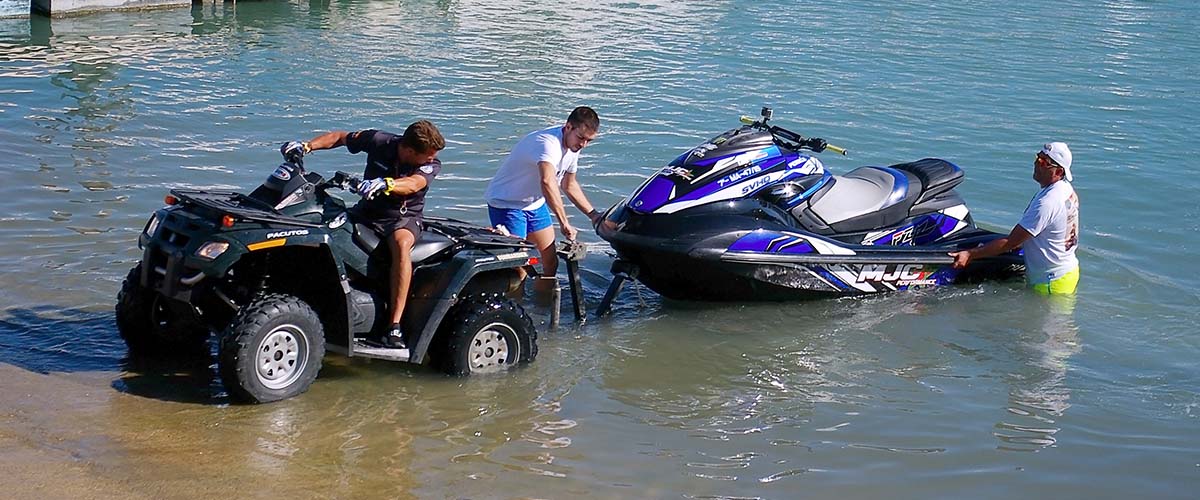
Practice this move by riding around, increasing your speed gradually, and shifting into higher gears. This practice will help you get familiar with driving your ATV. Remember that you also don’t need to concern yourself with shifting gears if you’re riding an automatic transmission. Still, work on a gradual speed increase to get more comfortable driving the ATV.
When slowing down, you’ll need to downshift to lower gears. Downshifting allows you to match the gear with the ATV speed. Hold the clutch using your left hand and use your left foot to press the gear shift lever down before releasing the clutch. As you shift back to lower gears, you’ll sense the lever click down. It’s a good idea to downshift one gear at a time to give your engine time to adjust to the lower gears and slower speeds.
Levers on the right and left sides of the handlebars control your ATV’s brakes. The right-side lever controls the rear brakes, while the left-side lever controls the front brakes. Start to brake with the rear wheels first by squeezing the right handle. To add additional braking power, slowly press the left handle.
The right-side lever controls the rear brakes, while the left-side lever controls the front brakes. Start to brake with the rear wheels first by squeezing the right handle. To add additional braking power, slowly press the left handle.
You want to avoid squeezing both brakes at the same time since you might topple over the handlebars. Furthermore, your ATV could also flip over if you press into the left handle to brake only the front wheels.
To distribute weight and prevent your ATV from tipping over, shift your weight into the direction you’re turning. For example, if you’re turning right, lean towards the right side of your ATV. Practice distributing your weight so that you can start taking turns at much higher speeds. A helpful trick here is to stand up from the seat when taking hard turns so you can lean further.
While you can take ATV driving lessons under an experienced rider, enrolling in a driving course is the best way to receive proper training.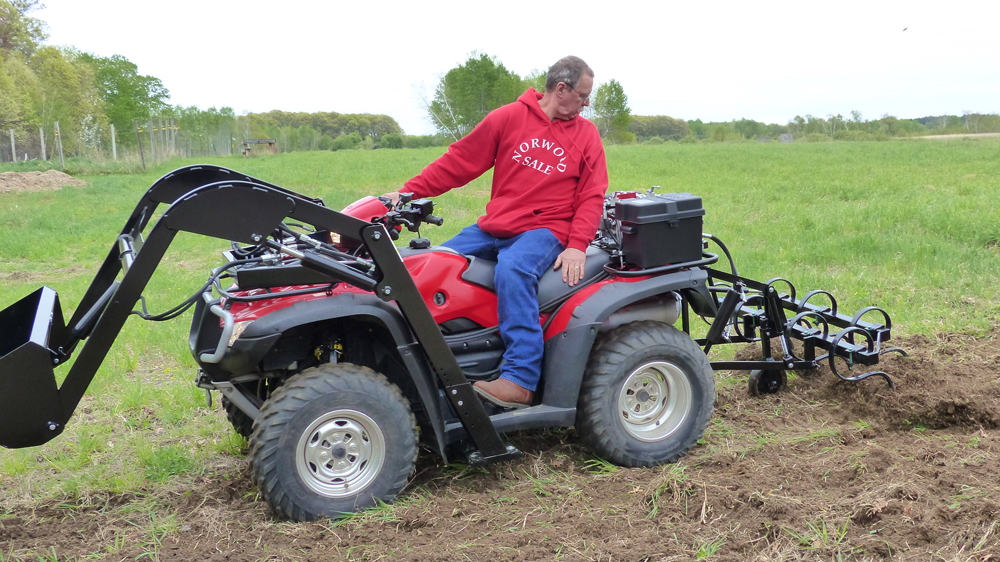 Once completed, you may also need to complete a certified course to enable you to drive your ATV legally.
Once completed, you may also need to complete a certified course to enable you to drive your ATV legally.
Below is a short video explaining how to drive a manual ATV:
ATVs are powerful machines that can become unstable or difficult to manage at high speeds. They can also reach speeds of up to 65 mph (104.6 kph) or higher. And, their high center of gravity, lack of roll bars, seatbelts, or safety cages means they can tip or even roll over easily.
As such, you need to protect yourself from rollovers, collisions, and injuries that may come from riding ATVs. The following tips are useful in helping you stay safe on four wheels:

Mastering any skill takes time, and learning how to drive an ATV is no exception. However, with regular practice, you’ll acquire all the skills you need for a fun, long ride.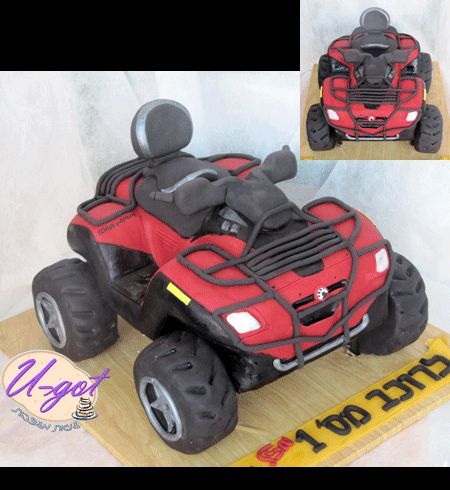 Try out different terrains and work on your coordination to enhance your ATV riding abilities. Soon, you’ll be ready to go on off-road adventures.
Try out different terrains and work on your coordination to enhance your ATV riding abilities. Soon, you’ll be ready to go on off-road adventures.
Sharing is caring!
Content
New models of ATVs are equipped with an electric starter. Therefore, problems with starting almost never arise. But in older models, 9 can be installed0029 manual kick starter . With him, beginners sometimes have difficulties.
To start the ATV, do the following:
 Also, the ignition switch must be in the "on" position on the control panel.
Also, the ignition switch must be in the "on" position on the control panel. 
Start the CFMOTO 500 with a manual starter?
Watch this video on YouTube
Paradoxically, but sometimes the owners of ATVs simply forget to pour gasoline into the tank. Therefore, before proceeding with the diagnosis, it is worth checking the fuel level.
It is not uncommon for the cause of the problem to be insufficient battery charge . It can be charged at home. If the ATV is small, you can purchase an additional battery. The cost of batteries for budget models is relatively low.
How to start an ATV?! If the battery is dead!? Life hacks! Subscriber reply | Irbis Atv 250s | SJ8Pro
Watch this video on YouTube
If the battery is good, but the starter does not work, it may be worth looking for the cause in the starting system. It is necessary to try to close the contacts, which are located on the starter relay. To do this, you need to use a screwdriver. The relay is usually located under the seat. Two thick wires are connected to it.
It is necessary to try to close the contacts, which are located on the starter relay. To do this, you need to use a screwdriver. The relay is usually located under the seat. Two thick wires are connected to it.
If you need to find a way to start the ATV without a key, you can also follow these steps. This technique will be effective only if the system is not controlled by the central computer . Otherwise, blocking will work.
If, after the manipulations, the engine starts up, then the problem is in the launch system . Otherwise, you will need to look for the cause of the malfunction further or visit a service center.
Each ATV has a stop button on the steering wheel. Usually it is red. This button is responsible for turning off the ignition, it turns off the engine . If you do not bring it to its previous position, the engine, of course, will not start. Therefore, it is worth checking in what position the "Stop" button is located.
Another security system provided in ATVs is a special check. This is a cable that is attached to the ATV at one end and to the driver at the other. If the latter falls off the ATV while driving, check flies out and the ignition turns off. You won't be able to start the vehicle without this receipt either. If this part is lost, you will need to look for the appropriate contacts and close them directly.
Another possible reason why the ATV won't start is a blown fuse. If the ATV is small, there is usually only one fuse. He is located next to the battery . The suitability of this part for operation can be assessed visually. The cost of the fuse is cheap, so it is better to have several of these parts in stock.
If there is no spare fuse, and the failure happened away from home, you can insert wire instead. This is a temporary solution that will allow you to get home. It is impossible to constantly replace the fuse with wire. You can burn much more expensive elements of the system.
It is impossible to constantly replace the fuse with wire. You can burn much more expensive elements of the system.
This part is located under the saddle or next to the motor (depending on the model). It's a small box with wires coming out of it. They are connected to the ignition coil. It is difficult to assess the health of this part, so it is better to contact a service center with a similar problem.
If the spark plug wire is broken or the ignition coil is broken, it will not be difficult to check the performance of these systems. The candle is unscrewed and inserted into the candle cap. Next, you need to attach it with the metal side to the engine and press the starter button. If there is no spark between the electrodes, this is a sign of a breakdown. Try cleaning the spark plug electrodes and adjusting the gap between them.
If there is a spark, then the problem lies either in the candle cap or in the candle. You need to buy a new part and change it.
You need to buy a new part and change it.
It will be possible to eliminate many malfunctions and start the ATV even in the forest. For models with a manual transmission, you can try to start the engine from the pusher. It should be said right away that this cannot be done with an automatic transmission. In other cases, it is recommended to look for the cause of the breakdown according to the points listed above.
How to start an ATV with a PUSHER
Watch this video on YouTube
Launch
- Before starting, it will be convinced of the correct position of the reverse lever
- not to hold the Start button more than 15 networks
- when starting, not to press the accelerator lever 9000
Warm -steering 9000
- it is important that it is important that it is important that it is important the engine is normally warmed up before being used. Allow the engine to run for at least 3-4 minutes until stable idling. In particularly cold conditions, the engine takes longer to warm up and the warm-up time increases. Cold seizing (cold seizing) and piston wear (when seizing), otherwise known as “four-way scuffing”, caused by operating the ATV with a slightly warm engine, is not covered by the warranty. After warming up, the engine should be warm
Allow the engine to run for at least 3-4 minutes until stable idling. In particularly cold conditions, the engine takes longer to warm up and the warm-up time increases. Cold seizing (cold seizing) and piston wear (when seizing), otherwise known as “four-way scuffing”, caused by operating the ATV with a slightly warm engine, is not covered by the warranty. After warming up, the engine should be warm
BEFORE DRIVING MANDATORY
- check: brake operation, additional engine switch, electrical equipment, suspension mounting bolts and nuts, tires, front suspension elements, steering systems, engine and transmission oil levels, passages and operation cooling systems
- free from dirt, and in winter from snow and ice drive shafts and steering rods, check their free play
DO NOT ALLOW
- prevent overheating of the engine and running gear; to prevent overheating, regularly drive into mud (wetlands), in winter - deep snow
- heavy load (high speed, intensive acceleration, etc.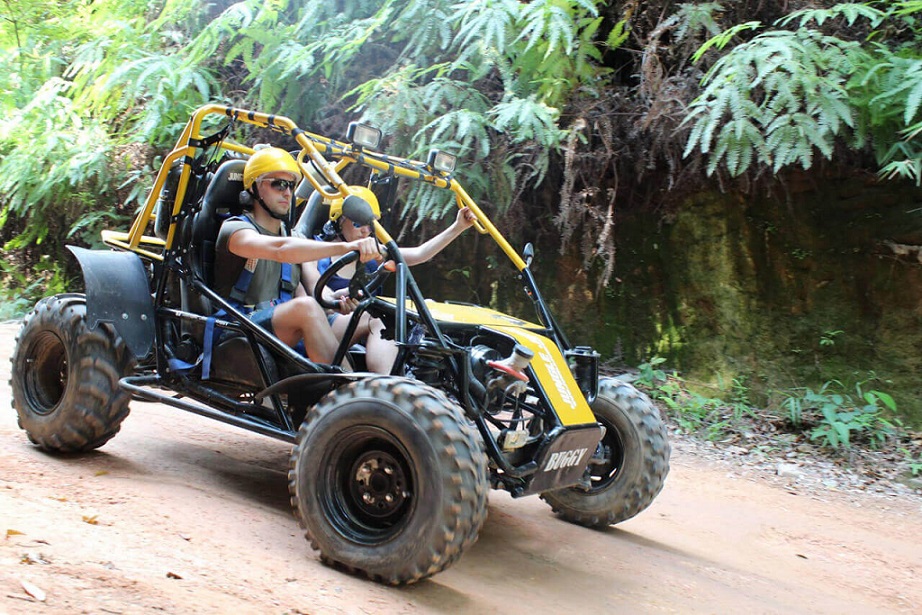 ) on the engine immediately after starting it and insufficient warming up
) on the engine immediately after starting it and insufficient warming up
- long operation in difficult conditions
- long driving in mud, sand
- turning off the ignition at speeds above idle, this can lead to a flash of the fuel mixture in the crankcase, which leads to isoflex grease being squeezed out of the engine and engine failure
- engine overheating.
The main features of overheating
1) The engine does not develop speed and power
2) ATV does not develop a maximum speed of
3) high engine temperature, extraneous smells, noise
Bkatka
- Duration of 500 km
- it is not allowed to fully open the throttle valve (more than ¾), it is necessary to make short accelerations and move at different speeds
- do not carry trailers or loads
- do not drive at high speed for a long time
- do not allow the engine and chassis to overheat
- regularly check the oil level in the oil tank; for reasons and contact your dealer
- during the first 50 km the drive belt is run in (every time a new one is installed).